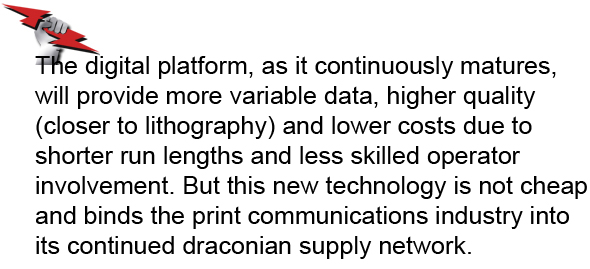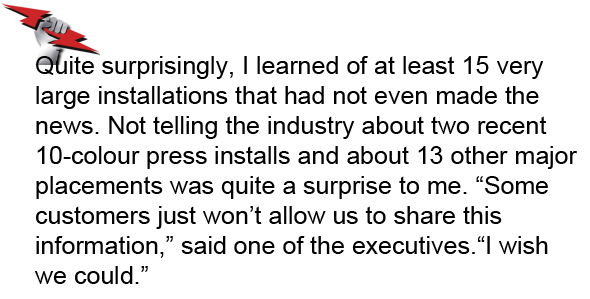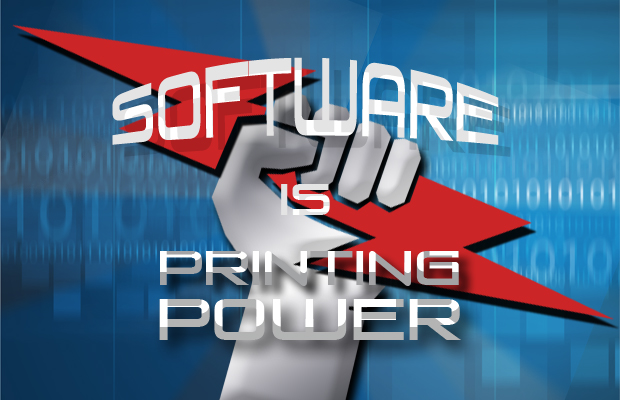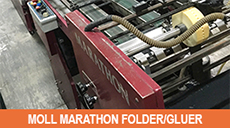For over 500 years, since the first bible was printed
mechanically and in multiplicity, the industry we call
Print has been one of exclusiveness and necessity.
Letterpress printers, for example, grew their businesses
by what inventory of fonts they had, by varieties
of type styles and sizes, choice of matrices and pure
quantity. If these printers also had the means to make
electros and cuts, or perhaps the newest hot-metal-casting
equipment, they could prosper simply by providing
more choice in style and product. Large font stockpiles
often meant winning a job based on greater firepower
alone. This environment of hardware strength flourished
through the 1980s and 90s as heavy-iron offset
presses flooded the printing world.
Printing power, however, is certainily no longer about
stockpiling fonts, nor is it commonly determined by
the size of an offset pressroom or its variety of printing
presses. To drive this point home, even today’s reemerging
letterpress industry can produce work without one
drawer of type. Relief plates, imaged on CTP devices are
used for producing large quantities of work with instant
layout and thousands of available font designs. Today’s
printing position is not about what hardware can reproduce,
but rather what software can create or drive.
Conventional litho print is expensive. It does not
update itself and requires constant raw-material input.
For an application-based example of this changing environment,
consider the recent resurgence of print catalogues
being produced by large online retailers. These
companies, however, will ultimatley turn toward their
own New Media platforms for engagement. It is only a
matter of time.
The Globe & Mail’s Susan Krashinsky recently reported
that marketers too are turning away from traditional
media. Krashinsky was referring to a late-2014
Ipsos Reid research poll of roughly 3,000 marketers and
ad agencies (see Figure 1). The poll results specifically
mention the continued downward interest in print as a
tool for the marketers. Ipsos Reid does caution that the
figures do not provide direct proof of where the money
is shifting, but explains the results do “reflect a sentiment
in the marketing community about where money
should be spent.”

Economic Modeling Specialists Intl. and Career-
Builder produced a study of projected high-skill occupations
growth to 2017. Of the various positions, software developers and computer systems analysts
are expected to grow at a 11 percent rate from 2014.
Marketing specialists and research analysts could see
the highest growth at 13 percent. This speaks again of
the New Media position, turning toward virtual and direct-
to-consumer tools. Print, as expected, is not even
on the list.
Digital printing machinery may offer an extension
to the plight of the traditional printing press, but not
a solution. The digital platform, as it continuously matures,
will provide more variable data, higher quality
(closer to lithography) and lower costs due to shorter
run lengths and less skilled operator involvement. But
this new technology is not cheap and binds the print
communications industry into its continued draconian
supply network. Everything from special inks and
substrates, toners and maintenance supplies need to
be purchased – often through a click-charge model –
directly from the manufacturer. After all, consumables
are the ultimate repeating source of revenue for vendors
in the existing supply chain.

Many well established printing businesses that cannot
generate enough sales revenue from software, as
opposed to their hardware, will secede from print altogether.
Litho press makers will not be any better off. A
new 40-inch, 6-colour press with standard automation
sells for between $1.8 and $2.2 million. More commercial
printers seeking to update their presses will do so
either through the used market, where costs run between
a half and two-thirds the price of new machine,
or continue on with whatever hardware is already on
their shop floor.
The latter is generally what is happening out in today’s
market, as it becomes more difficult to solve the
math on completely new printing equipment. Even
though there have been engineering strides in the last
five years, most presses are still essentially built on the
same platform. In the UK and Europe there are many
long perfectors and these machines come to market
with enormous impression counts. Some have in excess
of 350-million impressions. Many in the UK are
10- and 12-colour machines. Of all the platforms, the
long perfector as a used machine has suffered the most
in value retrenchment. Few buyers exist even though
these machines are replaced with new ones. This sort of
situation is right out of the digital platform and copier business: Good and needed when new, a boat anchor
when used. The investment in software yields a much
more palatable return than hardware in today’s printing
environment.
Peter Burns, VP and Research Director of the firm
Forrester Research, comments: “The pressure is on to
shift the focus to software and related business technology
services, which is where customers, investors and
partners see greater opportunity and value. Nobody digitally
disrupts by building multibillion-dollar processor
fabs any more. What companies need to do is differentiate
on software that improves business technology.”
The printing industry continues to have its bright
spots, too. Because of the continued simplicity of
printing a job and (in a large amount of cases) little
to no in-house preventative maintenance expenses,
some printers are doing fine as they either offer more
products or do the work for less. One particular new
development is the tendency of not disclosing new
machinery purchases. I recently had a conversation
with two executives of a very large press manufacturer.
Quite surprisingly, I learned of at least 15 very large
installations that had not even made the news. Not
telling the industry about two recent 10-colour press
installs and about 13 other major placements was quite
a surprise to me. “Some customers just won’t allow us
to share this information,” said one of the executives.
“I wish we could.”

Traditional print manufacturing has been turned on
its ear. Perhaps we have taken the lithographic press as
far is it can go. Litho is made for large runs at low cost.
Digital is not. Landa and the new platforms he hopes to
deliver soon will be very expensive and come with boiler
plate growing pains. This is a worry for an industry
that is saddled with low profit margins and little new
growth. However, digital is the future for print.
Just as Apple took credit for Xerox PARC’s Graphical
User Interface and Microsoft snared QDOS (Quick
& Dirty Operating System) from Tim Patterson, being
first with a new technology will mean little if people
do not know how to implement it. New technologies
being developed today can provide many powerful
tools needed to move quickly from massive mainframe
printing presses to smaller more adaptable
platforms. No longer can we measure our worth by what hardware we have.
|











